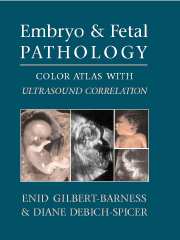Book contents
- Frontmatter
- Contents
- Foreword by John M. Opitz
- Preface
- Acknowledgments
- 1 The Human Embryo and Embryonic Growth Disorganization
- 2 Late Fetal Death, Stillbirth, and Neonatal Death
- 3 Fetal Autopsy
- 4 Ultrasound of Embryo and Fetus: General Principles
- 5 Abnormalities of Placenta
- 6 Chromosomal Abnormalities in the Embryo and Fetus
- 7 Terminology of Errors of Morphogenesis
- 8 Malformation Syndromes
- 9 Dysplasias
- 10 Disruptions and Amnion Rupture Sequence
- 11 Intrauterine Growth Retardation
- 12 Fetal Hydrops and Cystic Hygroma
- 13 Central Nervous System Defects
- 14 Craniofacial Defects
- 15 Skeletal Abnormalities
- 16 Cardiovascular System Defects
- 17 Respiratory System
- 18 Gastrointestinal Tract and Liver
- 19 Genito-Urinary System
- 20 Congenital Tumors
- 21 Fetal and Neonatal Skin Disorders
- 22 Intrauterine Infection
- 23 Multiple Gestations and Conjoined Twins
- 24 Metabolic Diseases
- Appendices
- Index
12 - Fetal Hydrops and Cystic Hygroma
Published online by Cambridge University Press: 23 February 2010
- Frontmatter
- Contents
- Foreword by John M. Opitz
- Preface
- Acknowledgments
- 1 The Human Embryo and Embryonic Growth Disorganization
- 2 Late Fetal Death, Stillbirth, and Neonatal Death
- 3 Fetal Autopsy
- 4 Ultrasound of Embryo and Fetus: General Principles
- 5 Abnormalities of Placenta
- 6 Chromosomal Abnormalities in the Embryo and Fetus
- 7 Terminology of Errors of Morphogenesis
- 8 Malformation Syndromes
- 9 Dysplasias
- 10 Disruptions and Amnion Rupture Sequence
- 11 Intrauterine Growth Retardation
- 12 Fetal Hydrops and Cystic Hygroma
- 13 Central Nervous System Defects
- 14 Craniofacial Defects
- 15 Skeletal Abnormalities
- 16 Cardiovascular System Defects
- 17 Respiratory System
- 18 Gastrointestinal Tract and Liver
- 19 Genito-Urinary System
- 20 Congenital Tumors
- 21 Fetal and Neonatal Skin Disorders
- 22 Intrauterine Infection
- 23 Multiple Gestations and Conjoined Twins
- 24 Metabolic Diseases
- Appendices
- Index
Summary
Minor hydrops is common, particularly in premature infants. Severe hydrops is generalized edema of 7.5 mm subcutaneous edema in a third-trimester fetus with an effusion of at least one body cavity, usually accompanied by polyhydramnios and edema of the placenta.
POLYHYDRAMNIOS
Amniotic fluid volume is approximately 800 mL at term. The volume is increased by fetal urine and is simultaneously removed by fetal swallowing. Fetal anomalies that interfere with swallowing are associated with polyhydramnios, while a decrease of fetal renal function and production of urine result in oligohydramnios. The volume of amniotic fluid falls rapidly after 40weeks gestation to about 400 mL at 42 weeks and 200 mL at 44 weeks. Polyhydramnios is the presence of an excess of 1,500 mL of amniotic fluid at term and is present in up to 1% of pregnancies.
Causes of polyhydramnios
I. Maternal
A. Diabetes and gestational diabetes
II. Fetal anomalies
A. Anencephaly
B. Esophageal atresia
C. Small intestinal obstruction
D. Diaphragmatic hernia
E. Central nervous system malformations
F. Chromosomal defects
III. Placenta
A. Chorangioma
FETAL HYDROPS (FH)
Hydrops fetalis (HF) has a mortality rate in excess of 90% (Tables 12.1 to 12.5).
Intrauterine diagnosis of hydrops by ultrasound may allow successful treatment and reversal in selected cases, but the majority die without an established causative diagnosis.
- Type
- Chapter
- Information
- Embryo and Fetal PathologyColor Atlas with Ultrasound Correlation, pp. 321 - 334Publisher: Cambridge University PressPrint publication year: 2004
- 1
- Cited by

